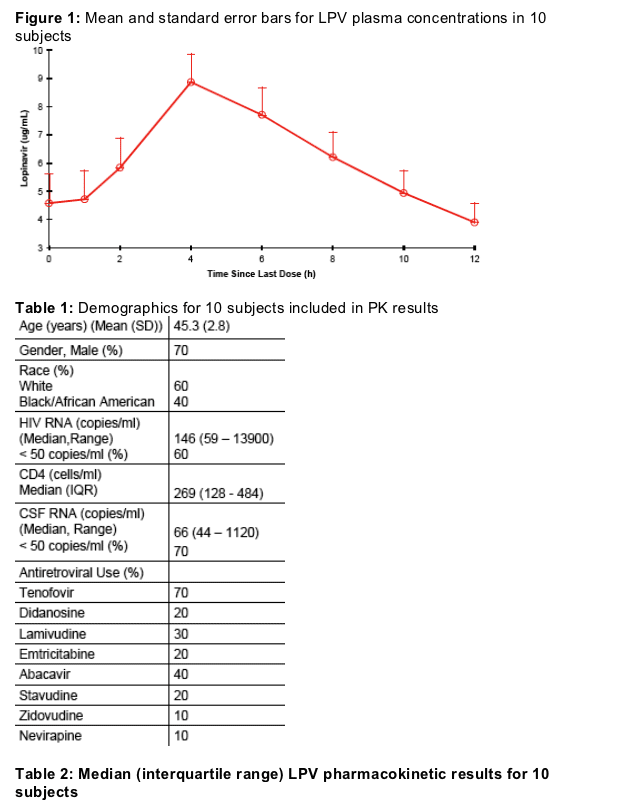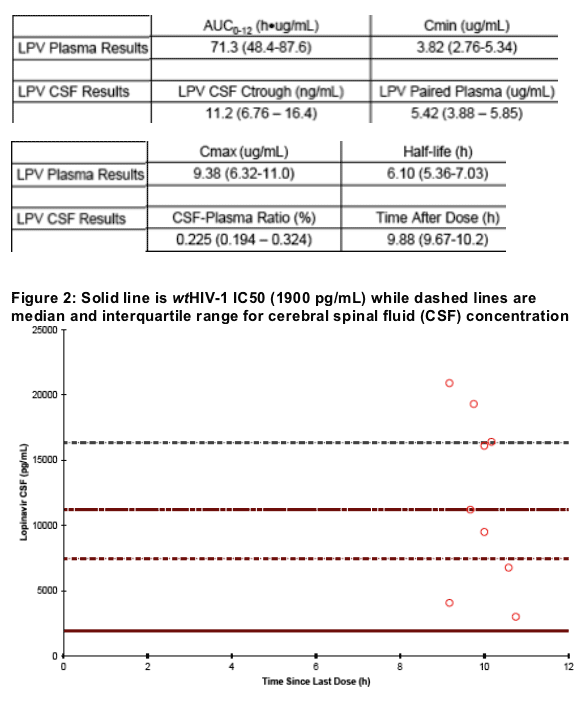 |
 |
 |
| |
Lopinavir (LPV) Cerebrospinal Fluid (CSF) Trough Concentrations in HIV-infected Adults
|
| |
| |
Reported by Jules Levin
ICAAC Sept 17-20, 2007, Chicago
Robert DiCenzo, Pharm.D., BCPS,1,2 Robin DiFrancesco, MBA,1 Kim Cruttenden, R.N., MS,2 Jamie Sommer, Pharm.D.3 and Giovanni Schifitto, M.D.2
1University at Buffalo, Buffalo, NY; 2University of Rochester, Rochester, NY; 3Abbott Laboratories
AUTHOR CONCLUSIONS
End of dosing interval LPV CSF concentrations were above the median IC50 for wtHIV-1 replication in all patients receiving LPV/r 400/100 mg soft-gel capsules twice daily.
Higher LPV plasma concentrations are associated with higher LPV CSF concentrations.
Increased CSF protein concentrations are associated with higher LPV CSF concentrations and a higher LPV CSF to plasma concentration ratio.
ABSTRACT
Background: The central nervous system may act as a sanctuary site for viral replication in the setting of low antiretroviral penetration. The purpose of the study was to describe LPV cerebrospinal fluid (CSF) trough concentrations in HIV-infected adults.
Methods: HIV-infected adults whose regimen included LPV/RTV 400/100 mg soft-gel capsules twice daily for > 4 weeks were enrolled. Study drug was administered with a standardized breakfast. Each subject had 8 plasma (HPLC)
samples over a 12 h dosing interval and 1 CSF sample (Ctrough) using a novel LCMS/MS method. Pharmacokinetic (PK) parameters were calculated using noncompartmental methods. Linear regression methods tested for associations
between CSF or CSF:plasma ratio and covariates including plasma PK, age, weight, CD4, and CSF protein.
Results: 10 patients (7 male; mean (SD) age = 45.3 (2.8) y) completed the study. Median (IQR) LPV plasma AUC0-12, Cmin and Cmax was 71.3 h•ug/mL (48.4-87.6), 3.82 ug/mL (2.76-5.34) and 9.38 ug/mL (6.32-11.0), respectively. LPV CSF calibration range was 0.250 to 20.0 ng/mL; interassay variation at 0.6, 1.6 and 16 ng/mL was 8%, 7% and 12%, respectively; and accuracy was validated within ± 10%.
Median (IQR) CSF Ctrough, paired plasma concentration and time since last dose were 11.2 ng/mL (6.76 - 16.4), 5.42 ug/mL (3.88 - 5.85) and 9.9 h (9.7 - 10.2), respectively.
CSF:Plasma ratio was 0.225% (0.194-0.324).
LPV CSF Ctrough was above the median IC50 (1.90 ng/ml) in all subjects.
LPV plasma AUC0-12 (r2 = 0.65; p = 0.009) and CSF protein (r2 = 0.26; p = 0.006) were associated with LPV CSF concentration (r2 = 0.91; p = 0.0008) while CSF protein (r2 = 0.66; p = 0.008) was associated with CSF:plasma
concentration ratio.
Conclusions: End of dosing interval LPV CSF concentrations were above the median IC50 for wtHIV-1 replication in all patients receiving a LPV/r 400/100 mg BID containing regimen.
INTRODUCTION
A better understanding of the disposition of antiretroviral agents in the central nervous system (CNS) is important for a number of reasons including the concern that the CNS may act as a sanctuary site for viral replication. Distribution of drug into compartments outside of the plasma is dependent on a number of factors including protein binding in both the plasma and the compartment being sampled and drug extrusion by transporter proteins. Information concerning PI
concentrations in the CNS is sparse, particularly at the end of a dosing interval. The purpose of this study was to describe LPV CSF concentrations sampled at the end of a dosing interval (Ctrough) in HIV-infected adults.
METHODS
Study Design: Open label, pharmacokinetic design
Subjects: HIV-1 infected adults whose regimen included LPV/RTV 400/100 mg soft-gel capsules twice daily for at least 4 weeks.
Study Drug: Each subject received study drug with a standardized
breakfast during their PK visit.
Blood Sampling: Subjects were admitted to the GCRC at the University of Rochester Medical center after fasting since 10 pm the night before. Time of administration for the last three doses of study medication before the PK visit was used to determine adherence. Blood samples were drawn pre-dose and at 1, 2, 4, 6, 8, 10 and 12 hours after the morning dose of study drug. CSF samples were collected via lumbar puncture with or without fluoroscopy guidance.
Assay: Lopinavir plasma concentrations were measured using a New York State certified method for plasma protease inhibitor quantitation utilized within the Pharmacotherapy Research Center Core Analytical Laboratory at the University at Buffalo.1 The lower limit of quantitation for LPV in plasma was 200 ng/mL. Lopinavir CSF concentrations were calculated using a recently published LCMS/MS method.2 CSF calibration range was 0.250 to 20.0 ng/mL; interassay variation at 0.6, 1.6 and 16 ng/mL was 8%, 7% and 12%, respectively; and accuracy was validated within ± 10%.
Pharmacokinetic and Statistical Analyses: Standard non-compartmental techniques were used to calculate pharmacokinetic parameters using WinNonlin Version 4.1 (Pharsight, Palo Alto, CA). Univariate results are listed as Spearman Correlation Coefficients. Multiple linear regression with forward stepwise elimination was used to test for associations between CSF or CSF:plasma concentration ratio and variables including plasma PK, age, weight, CD4 at baseline, and CSF protein. SASŪ System v8 (SAS Institute, Cary, NC) was used for statistical analysis.
RESULTS
Subjects
Ten subjects completed the study.
Age, gender, race, plasma and CSF viral load, baseline CD4 count and concomitant antiretroviral medications are listed in Table 1.
Pharmacokinetic Results
LPV plasma concentrations and pharmacokinetic parameters appear to be within the range of previously reported results (Figure 1 and Table 2).
Median (IQR) CSF Ctrough, paired plasma concentration and time since last dose were 11.2 ng/mL (6.76 - 16.4), 5.42 ug/mL (3.88 - 5.85) and 9.9 h (9.7 - 10.2), respectively (Table 2).
LPV CSF concentrations were above the median IC50 for wtHIV-1 replication (1.90 ng/mL) in all patients (Figure 2).
Median (IQR) LPV CSF to plasma concentration ratio was 0.225% (0.194-0.324).
During univariate analysis higher LPV steady state AUC0-12 (r2 = 0.82; p = 0.0003), Cmax (r2 = 0.77; p = 0.009), and Cmin (r2 = 0.78; p = 0.008) were associated with higher LPV CSF concentrations while higher CSF protein concentration (r2 = 0.90; p = 0.008) was associated with higher LPV CSF to plasma concentration ratio.
Increased LPV plasma AUC0-12 (r2 = 0.65; p = 0.009) and CSF protein concentration (r2 = 0.26; p = 0.006) were associated with higher LPV CSF concentration (r2 =0.91; p = 0.0008) while only higher CSF protein concentration (r2 = 0.66; p = 0.008) was associated with higher LPV CSF to plasma concentration ratio during multivariate analysis.
Only subjects with a detectable plasma viral load had a detectable CSF viral load (n=3). The only subject to have a detectable plasma VL without a detectable CSF VL had a plasma VL of only 59 copies/ml.


|
| |
|
 |
 |
|
|